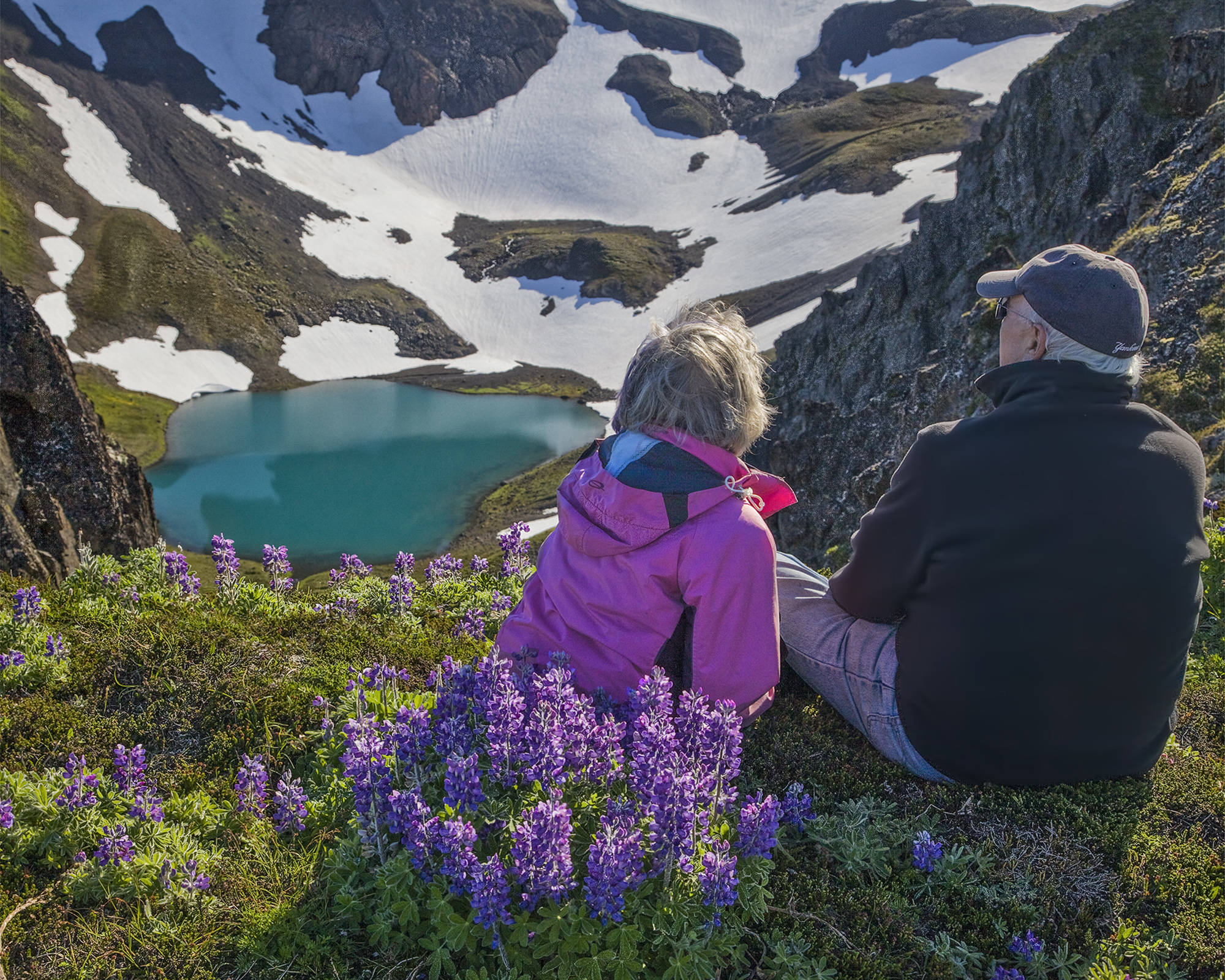Just like a hobbit can take a second breakfast, some people get a second retirement — a closing of a career after previous work. After moving from the Lower 48 and settling in Homer, artists Mary Frische and Tom Collopy this month ended their environmental photography business, Wild North Photography, with a final gallery show at Fireweed Gallery.
They’re not fading away, but have shut down the business, website, printing shop, 800 phone number and all. They’re even winnowing their camera kits to two bodies and six lenses.
“It was just time,” Collopy said in an interview Tuesday at the couple’s Diamond Ridge home.
In a town that lures interesting people to retire, Frische and Collopy have one of the more fascinating adventures. To start, they came into the country right before Sept. 11, crossing the border near Tok with everything they owned in a 24-foot Freightliner truck. They had a hint something horrible had happened when they stopped at the Eureka Lodge and noticed everyone watching the TV.
“It was deathly quiet in there,” Frische said.
Frische, 82, and Collopy, 74, have known each other most of their lives. They’re first cousins, part of a pack of 42. They got reacquainted in St. Paul, Minnesota, after Frische’s first husband died in 1992, and married in 1996.
Collopy, who worked for Northwest Airlines in flight dispatch, had begun visiting Alaska in the 1990s and got hooked on the state.
“I realized if I’d come up here when I was 20 I would have never left,” Collopy said.
They fell in love with Homer on a visit in the 1990s when they stayed at the old Bayview Inn with its Kachemak Bay panorama. They had to leave early to catch a flight, and Collopy kept telling Frische they had to go.
“I’m sorry,” Frische said she told him. “We’re not going.”
They bought a view lot on the southwest slope of Diamond Ridge overlooking the head of the bay and Augustine and Iliamna volcanoes across Cook Inlet. As they planned their move north from Minnesota, they hired Beachy Construction to build them a home, with a deadline of mid-September 2001 to have done a closed-in shell, with one working electrical circuit, and water and septic. The first night of their arrival they installed a toilet.
The couple both came to photography in their youth.
“High school, college, I was the resident photographer,” Frische said. “It just sort of happened.”
Frische also painted and sculpted, mostly real-life studies. Busts of her children sit on shelves in their home as a reminder of her earlier career.
That artistic sensibility shows in their work, a wide variety of images of all things Alaskan. Their photographs can be as intimate as the petals of a fireweed stalk and as broad as an Aleutian Island cove.
“We didn’t make much money, but it was a great experience and the chance to have some impact on making what people value,” Collopy said.
Working with the U.S. Fish and Wildlife Service, the federal agency managing America’s wildlife refuges, they photographed six of Alaska’s wildlife refuges, from Homer’s own Alaska Maritime National Wildlife Refuge to Kanuti NWR near the Arctic Circle.
Fish and Wildlife provided their way to some of the most amazing country in the state, and in return they photographed the refuges and made exhibits.
Many of the photos shown at the Alaska Islands and Ocean Visitor Center they shot.
“We went to wonderful, wonderful places,” Frische said. “It was fabulous.”
Frische and Collopy got their first break when they met former Kachemak Heritage Land Trust director Barb Seaman on a guided KHLT hike to Grewingk Glacier.
Seaman asked them to photograph KHLT’s land trust properties and the people who had donated conservation easements. That resulted in an exhibit at the Pratt Museum and later at the Anchorage Museum.
“It was really fascinating to do,” Frische said. “We got to meet people who were pioneers.”
Their photography expeditions sometimes led to close encounters with wildlife, birds and walruses and, of course, bears.
They camped at Hallo Bay where the only other person was Tim Treadwell, the notorious “Bear Man” who would later be killed by a bear.
“We were so close to bears I counted 42,” Frische said. “There was a small hill. You could go up there and hear the cubs suckling.”
One time two adolescent bears playing saw Frische and a friend and rushed toward them, coming within 10 feet.
“Eva and I both started roaring and putting our arms up and advancing toward those two bears,” Frische said, convincing the bears to back off. “I only later got scared.”
One of the neatest photo shoots they did came from their car at Tern Lake at the Sterling and Seward Highways intersection. A group of tundra swans paddled in the lake, and the photographers slowly drove along the edge, swapping cameras as they had to turn their car around. If they had gotten out, the swans would have flown away.
Over their Alaska career, like many 21st century photographers they made the switch from film to digital. Collopy said even the earliest digital cameras had higher resolution than film.
“It was no contest,” he said. “…Now you get better pictures with your phone.”
Collopy said he liked the Kanuti NWR shoot the best. One of Frische’s favorite photos is of a huge flock of sandhill cranes flying in front of Denali.
“People would give an arm and a leg to go to some of the places we’ve been,” she said.
Though they’re retiring from professional photography, Frische and Collopy will still shoot for themselves. They have trips planned to McCarthy in June and along the Dempster Highway in the fall. While their stock lasts, their work will be on sale at the Fireweed Gallery and this summer when High Tide Arts reopens on the Spit.
Michael Armstrong can be reached at marmstrong@homernews.com.


